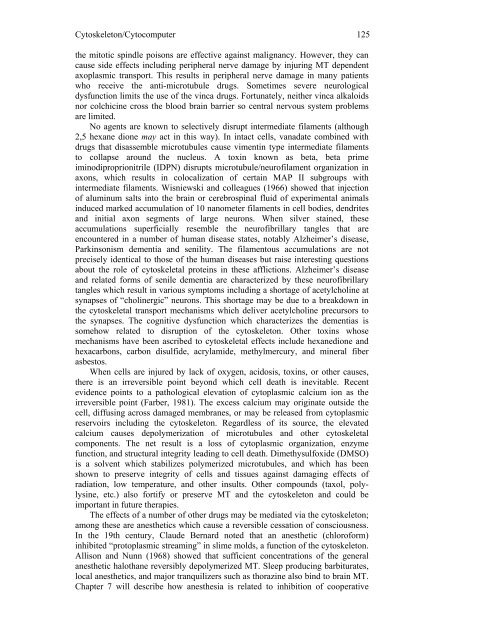ULTIMATE COMPUTING - Quantum Consciousness Studies
ULTIMATE COMPUTING - Quantum Consciousness Studies
ULTIMATE COMPUTING - Quantum Consciousness Studies
- No tags were found...
You also want an ePaper? Increase the reach of your titles
YUMPU automatically turns print PDFs into web optimized ePapers that Google loves.
Cytoskeleton/Cytocomputer 125<br />
the mitotic spindle poisons are effective against malignancy. However, they can<br />
cause side effects including peripheral nerve damage by injuring MT dependent<br />
axoplasmic transport. This results in peripheral nerve damage in many patients<br />
who receive the anti-microtubule drugs. Sometimes severe neurological<br />
dysfunction limits the use of the vinca drugs. Fortunately, neither vinca alkaloids<br />
nor colchicine cross the blood brain barrier so central nervous system problems<br />
are limited.<br />
No agents are known to selectively disrupt intermediate filaments (although<br />
2,5 hexane dione may act in this way). In intact cells, vanadate combined with<br />
drugs that disassemble microtubules cause vimentin type intermediate filaments<br />
to collapse around the nucleus. A toxin known as beta, beta prime<br />
iminodiproprionitrile (IDPN) disrupts microtubule/neurofilament organization in<br />
axons, which results in colocalization of certain MAP II subgroups with<br />
intermediate filaments. Wisniewski and colleagues (1966) showed that injection<br />
of aluminum salts into the brain or cerebrospinal fluid of experimental animals<br />
induced marked accumulation of 10 nanometer filaments in cell bodies, dendrites<br />
and initial axon segments of large neurons. When silver stained, these<br />
accumulations superficially resemble the neurofibrillary tangles that are<br />
encountered in a number of human disease states, notably Alzheimer’s disease,<br />
Parkinsonism dementia and senility. The filamentous accumulations are not<br />
precisely identical to those of the human diseases but raise interesting questions<br />
about the role of cytoskeletal proteins in these afflictions. Alzheimer’s disease<br />
and related forms of senile dementia are characterized by these neurofibrillary<br />
tangles which result in various symptoms including a shortage of acetylcholine at<br />
synapses of “cholinergic” neurons. This shortage may be due to a breakdown in<br />
the cytoskeletal transport mechanisms which deliver acetylcholine precursors to<br />
the synapses. The cognitive dysfunction which characterizes the dementias is<br />
somehow related to disruption of the cytoskeleton. Other toxins whose<br />
mechanisms have been ascribed to cytoskeletal effects include hexanedione and<br />
hexacarbons, carbon disulfide, acrylamide, methylmercury, and mineral fiber<br />
asbestos.<br />
When cells are injured by lack of oxygen, acidosis, toxins, or other causes,<br />
there is an irreversible point beyond which cell death is inevitable. Recent<br />
evidence points to a pathological elevation of cytoplasmic calcium ion as the<br />
irreversible point (Farber, 1981). The excess calcium may originate outside the<br />
cell, diffusing across damaged membranes, or may be released from cytoplasmic<br />
reservoirs including the cytoskeleton. Regardless of its source, the elevated<br />
calcium causes depolymerization of microtubules and other cytoskeletal<br />
components. The net result is a loss of cytoplasmic organization, enzyme<br />
function, and structural integrity leading to cell death. Dimethysulfoxide (DMSO)<br />
is a solvent which stabilizes polymerized microtubules, and which has been<br />
shown to preserve integrity of cells and tissues against damaging effects of<br />
radiation, low temperature, and other insults. Other compounds (taxol, polylysine,<br />
etc.) also fortify or preserve MT and the cytoskeleton and could be<br />
important in future therapies.<br />
The effects of a number of other drugs may be mediated via the cytoskeleton;<br />
among these are anesthetics which cause a reversible cessation of consciousness.<br />
In the 19th century, Claude Bernard noted that an anesthetic (chloroform)<br />
inhibited “protoplasmic streaming” in slime molds, a function of the cytoskeleton.<br />
Allison and Nunn (1968) showed that sufficient concentrations of the general<br />
anesthetic halothane reversibly depolymerized MT. Sleep producing barbiturates,<br />
local anesthetics, and major tranquilizers such as thorazine also bind to brain MT.<br />
Chapter 7 will describe how anesthesia is related to inhibition of cooperative






